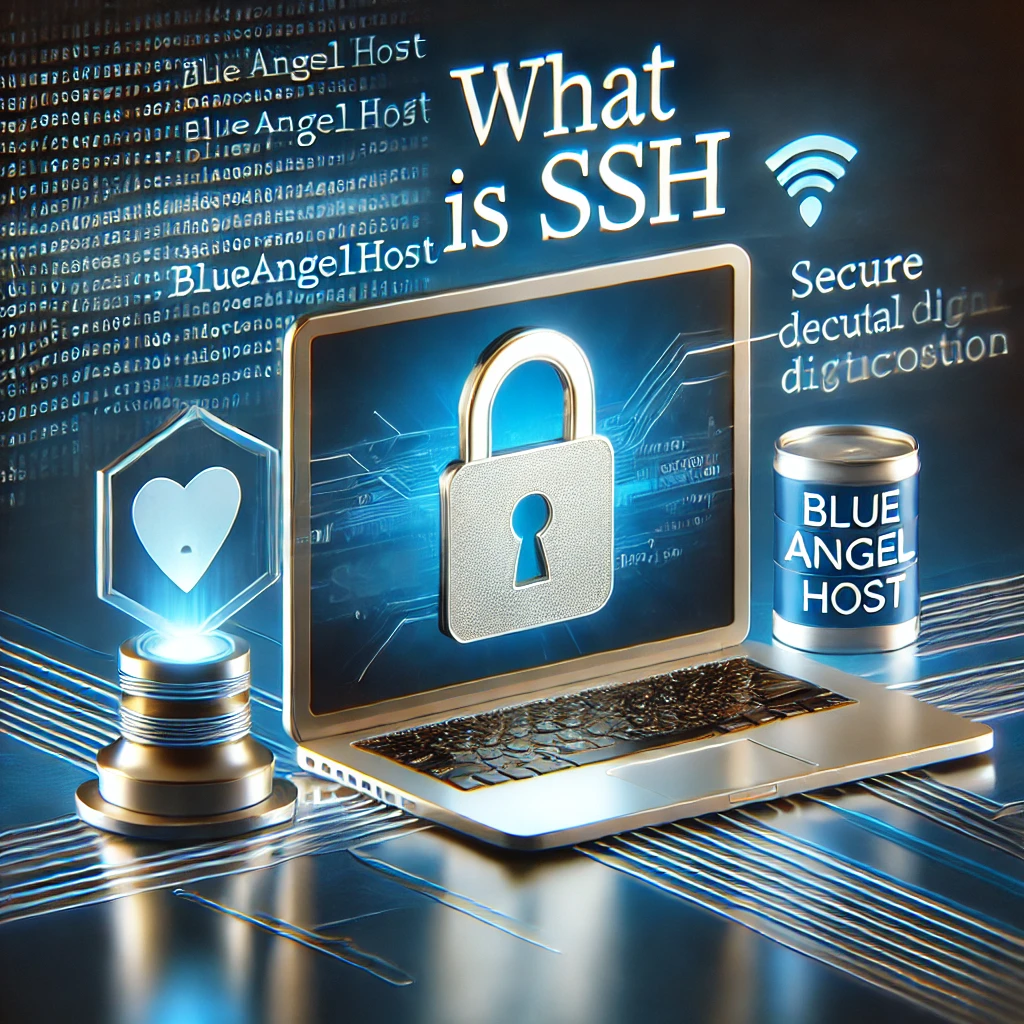What is SSH? The Essential Guide to Secure Shell Protocol for Remote Access
In a world where digital security is critical, understanding “What is SSH” and how it functions is essential. SSH, also known as Secure Shell, is a protocol that secures connections between devices, encrypting data and ensuring that sensitive information is kept safe from unauthorized access. SSH has become the preferred choice for secure remote connections and is widely used by system administrators, developers, and IT professionals worldwide.

Table of Contents
What is SSH? Breaking Down the Secure Shell Protocol
So, what is SSH exactly? SSH, or Secure Shell, is a network protocol that facilitates secure access and communication between two systems over an unsecured network. By encrypting all transmitted data, SSH protects information, commands, and credentials from being intercepted. Whether you’re accessing a Dedicated Server, transferring files, or executing commands remotely, SSH is invaluable for secure operations.
At its core, SSH replaces older protocols like Telnet and unencrypted FTP by providing robust data protection, encryption, and authentication. This makes SSH the leading solution for secure, remote communication.
The Importance of SSH for Remote Security
SSH plays a crucial role in digital security for several reasons:
- Data Encryption: SSH encrypts all data transferred between the client and server, ensuring data remains private.
- Authentication Mechanisms: SSH offers several methods for secure authentication, including passwords, public keys, and multi-factor authentication.
- Integrity Verification: SSH verifies data integrity, ensuring that data hasn’t been altered during transmission.
- Cross-Platform Compatibility: SSH is compatible with various platforms, including Windows, macOS, and Linux, making it highly versatile.
These features help explain why understanding “What is SSH” is so important for secure and efficient remote system management.
How Does SSH Work? Key Components of the SSH Protocol
To grasp what SSH is, it’s helpful to understand how SSH works, particularly the processes of authentication and encryption. Here’s a step-by-step look:
1. SSH Key Exchange
The first step in establishing an SSH connection is a secure key exchange. SSH uses this exchange to create encryption keys, allowing the client and server to communicate securely without actually sharing the keys over the network.
2. Authentication Protocols in SSH
To ensure that both the user and server are legitimate, SSH supports multiple authentication protocols:
- Password-Based Authentication: The user is prompted to enter a password to access the server. While commonly used, password-based authentication is less secure than other methods.
- Public Key Authentication: This method uses a private key on the client side and a public key on the server. When the keys match, the server grants access, offering a higher level of security.
- Multi-Factor Authentication (MFA): Some SSH configurations use MFA, combining something the user knows (password) with something they have (a secondary device or token).
3. Encryption of Data
Once the connection is authenticated, SSH encrypts all data transmitted, securing the session. SSH uses algorithms like RSA and AES to create a secure, encrypted communication channel, ensuring data protection.
Exploring SSH Key Features and Benefits
Understanding what SSH is also involves recognizing its features and the advantages it provides:
- Enhanced Security: SSH’s encryption and multifactor authentication features make it a highly secure protocol.
- Remote Access and Control: SSH allows users to control and access remote servers as if they were local, supporting system administration and troubleshooting.
- Port Forwarding and Tunneling: SSH supports port forwarding, a feature that directs traffic from unsecured applications through SSH for encrypted transport.
- Versatile Commands: SSH enables efficient command execution across systems, allowing users to navigate remote systems and transfer files securely.
These features explain why “What is SSH?” is a frequently asked question among those involved in system administration and IT security.
Common SSH Commands and How to Use Them
SSH commands are essential for working remotely with servers. Here’s a look at some common SSH commands:
- ssh [user@hostname] – Establishes an SSH connection to a server.
- scp [file] [user@hostname:/directory] – Uses SSH to copy files between local and remote systems.
- sftp – Provides a secure way to transfer files using SSH File Transfer Protocol.
- ssh-keygen – Generates SSH key pairs for secure access.
- ssh-add – Manages SSH keys for seamless login.
For anyone wondering what SSH is and how to use it, these commands are the foundation of effective and secure remote work.
What is SSH Port Forwarding? Enhancing Security with SSH Tunneling
SSH port forwarding, also known as tunneling, is another powerful feature that enhances data security by redirecting network traffic:
- Local Port Forwarding: Secures local traffic by forwarding it to a specified port through an SSH connection.
- Remote Port Forwarding: Redirects traffic from the server to a local port, creating a secure bridge for incoming traffic.
- Dynamic Port Forwarding: Allows users to set up a dynamic proxy, routing various types of network traffic through an SSH tunnel.
Port forwarding is a practical application of SSH for securing traffic that would otherwise be unprotected.
SSH Best Practices for Key Management and Security
To make the most of SSH, adhering to key management and security best practices is essential:
- Implement Strong Key Pairs: Use key pairs of at least 2048 bits to enhance security.
- Limit Root Access: Disabling direct root logins and using sudo privileges can reduce security risks.
- Use Passphrase-Protected Keys: Adding a passphrase to private keys provides extra security in case of unauthorized access.
- Rotate Keys Periodically: Changing keys periodically helps prevent unauthorized access in the event of compromise.
When asking “What is SSH?” the answer should always include best practices to ensure maximum security.
SSH vs. Other Remote Access Protocols
Though SSH is widely used, it’s helpful to understand how it compares to alternatives:
- RDP (Remote Desktop Protocol): RDP provides graphical access for remote control, particularly suited for Windows-based systems.
- VPN (Virtual Private Network): VPNs encrypt data over public networks but differ in purpose; they secure browsing while SSH secures system access.
- Telnet: An older protocol similar to SSH, Telnet lacks encryption, making it less secure.
Among these, SSH remains the preferred protocol for secure remote access, thanks to its encryption and flexibility.
Applications of SSH in Real-World Scenarios
Understanding “What is SSH” reveals that it is highly versatile. Beyond remote access, SSH is used in various scenarios:
- Automated File Transfers: SSH can automate file transfers and backup operations, essential for data consistency.
- Version Control with Git: SSH securely connects to repositories, allowing users to manage code safely.
- System Monitoring: SSH enables administrators to run monitoring scripts and commands on remote systems, facilitating maintenance.
SSH is indispensable across numerous industries for these practical applications, contributing to its popularity.
Frequently Asked Questions
What makes SSH secure?
SSH uses encryption and authentication protocols that prevent unauthorized access and data interception.
Can I use SSH on Windows?
Yes, SSH is available on Windows, with tools like OpenSSH and PuTTY facilitating secure connections.
What is SSH’s default port?
SSH typically operates on port 22, though it can be changed for added security.
How does SSH differ from SSL?
SSH secures remote system access, while SSL (Secure Sockets Layer) secures data over the web, such as online transactions.
How can I set up SSH key-based authentication?
You can use the ssh-keygen command to create a key pair, then upload the public key to the server for secure access.
Is SSH completely secure?
While SSH is highly secure, following best practices such as key management and multifactor authentication ensures the highest security level.
Conclusion
Understanding “What is SSH” is essential for anyone looking to secure their digital environment. As a protocol, SSH provides robust security, flexibility, and ease of use for remote access and server management. By using SSH effectively, IT professionals and developers can ensure secure, reliable remote connections, protecting both data and infrastructure.






